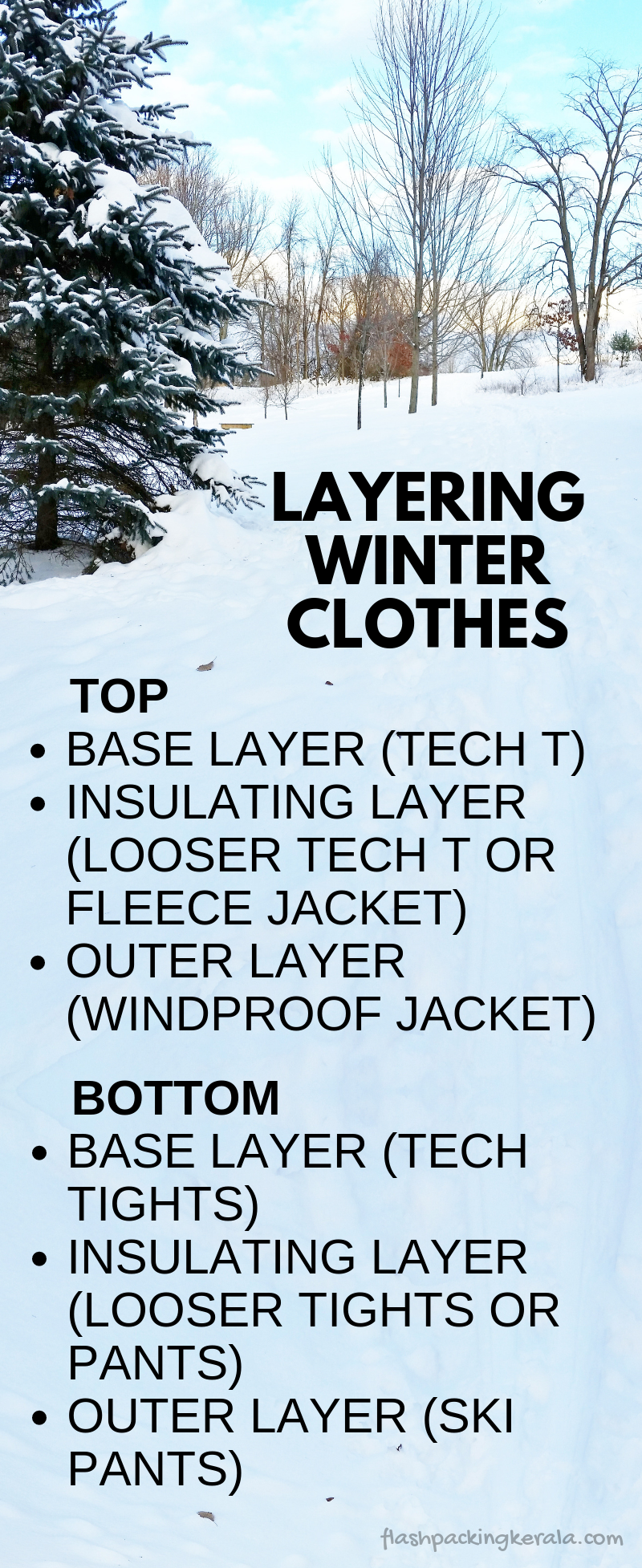Look for an outer layer that is water-resistant but still breathable. A lot of what I carry in my pack during the shoulder season is what I wear during winter.

Pin By Lucy Deacon On Hiking Winter Layering Guide Winter Layering Winter Running
When your body gets warm its mechanism for cooling itself down is to sweat or perspire.

How to layer clothes for winter hiking. This will protect you from the elements and keep your other layers dry. How to Layer Clothes in Winter When setting off on a day trip in the outdoors its essential that you have the right clothing to handle the conditions youll face. Other examples include hat liners glove liners and sock liners.
If the hiker is wearing wet clothing swap it out for dry clothes and make sure the hiker is well-insulated. Base Layer for Winter Hiking The base layer goes next to your skin and may also be referred to as long underwear or thermal underwear. Even if you dont think itll get cold bring a mid-layer if youll be out for more than a few hours.
When choosing your winter hiking clothes here are the three layers to think about. For winter hiking this usually means wearing long underwear. You dont want a super heavy ski jacket for instance.
The base layer is available in. Or a wicking light weight tank top might become your mid layer in warm weather. A mid-layer is one of the 10 essential pieces of hiking gear.
You dont want to sweat because wet clothes will make you cold for the rest of the hike. Base layer fleece layer and a waterproof outer shell. There isnt much sense in hiking in a huge coat as.
Choose a base layer to manage perspiration. Insulating Layers You should still be choosing wicking fabrics synthetics or wool for this layer. On the bottom hiking parts are typically worn as a mid layer.
So you just take off a layer or two. For winter hiking this usually means wearing long underwear. Winter season means preparing for bad weather and carrying more gear.
You have three primary layers while winter hiking. From ultralight softshells to heavy-duty hard shells outer layer pants cover the full spectrum. For women hikers the inner layer of clothing starts with a sports bra recommended regardless of the generosity of your endowment to prevent chafing undies and sometimes a warm sleeveless shirt tank top if you know youll be wearing more layers.
A fleece sweater makes for an excellent mid layer. Your insulating layer is usually thicker than your base and primary layers although in mild weather I might just carry a second base layer. As the next-to-skin layer a base layers job is moving perspiration away from your skin aka wicking.
Layering allows you to shed or add clothing as you need. With the right treatment hikers with mild hypothermia can possibly recover and continue on the trip. When choosing your winter hiking clothes here are the three layers to think about.
Its main purpose is to draw perspiration away from your skin and disperse it while providing some insulation. There is a fourth magical layer that comes in handy when youre taking a break or temps are truly rugged. This is the layer that pulls sweat and precipitation away from your skin.
And many people add a middle layer on top andor outer layer at every rest stop just to avoid getting chilled. If hiking alone isnt warming you up add a middle layer. Lower Body Outer Layers Your options for lower body outer layers are virtually identical to those for your upper body.
How to Layer Winter Hiking Clothes The key to staying warm while winter hiking is to layer up and layer right. Even in freezing weather the exertion will get your heart pumping and your temperature rising. If its sleeting snowing raining or windy youll want to add an outer shell over your winter hiking clothes.
There are many advantages here. Hiking up a hill is hard work. Winter Hiking Outer Layer.
However the weather can change throughout the day particularly here in the UK so its likely youll need to adapt to a range of conditions. Give the person water and food so they have enough energy to shiver which is your bodys natural way of producing more heat. Layering simply put is wearing several layers to provide your protection instead of relying on one.
This is the first line of defense and also helps absorb any sweat that body produces during the trek. The first layer is the base layer and is closest to your skin apart from your underwear. Consider a breathable hardshell option if you plan on doing a lot of winter hiking or live in rainy coastal environments.
Now to be honest a cotton t-shirt is not the most ideal base layer. BASE LAYER This is the layer that pulls sweat and precipitation away from your skin. Your pack will be heavier and you will need to stop and rotate layers more in winter than any other season.
Lets look at how to layer clothes for winter hiking. 4 Suggested Layers for Winter Treks Layer 1.

How To Layer Clothes For Cold Weather Winter Vacation Tips Outdoor Travel Gear Flashpacking Kerala Winter Cold Weather Cold Weather Running In Cold Weather

How To Layer Clothes For Cold Weather Winter Vacation Tips Outdoor Travel Gear Flashpacking Kerala Winter Layering Outfits Winter Camping Outfits Winter Travel Outfit

Layering Basics Hiking Outfit Hiking Outfit Women Hiking Outfit Winter

Winter Hiking Clothes Cold Weather Layering Basics Trekking Outfit Women Hiking Outfit Women Trekking Outfit
